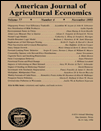Plant Succession as a Natural Range Restoration Factor in Private Livestock Enterprises
Abstract
We formulate a grazing model linking privately optimal stocking rates to their longterm impacts on the succession of plant species on rangeland. The fast (annual) dynamics of a grazing-decision component are put in phase with the slow (decadelong) dynamics of a plant-succession component via the “slow-manifold” theory of dynamical systems. The model provides the context for analytically approximating “successional thresholds,” partitioning rangeland conditions into those gravitating toward socially desirable or socially undesirable plant compositions over time. These thresholds are instrumental in determining whether grazing management alone can restore rangeland to a socially desired plant composition.




